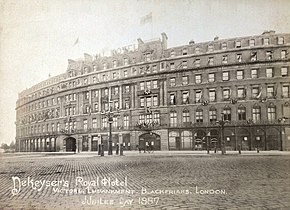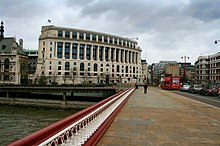
Victor Pierre Horta was a Belgian architect and designer, and one of the founders of the Art Nouveau movement. He was a fervent admirer of the French architectural theorist Eugène Viollet-le-Duc and his Hôtel Tassel in Brussels (1892–93), often considered the first Art Nouveau house, is based on the work of Viollet-le-Duc. The curving stylized vegetal forms that Horta used in turn influenced many others, including the French architect Hector Guimard, who used it in the first Art Nouveau apartment building he designed in Paris and in the entrances he designed for the Paris Metro. He is also considered a precursor of modern architecture for his open floor plans and his innovative use of iron, steel and glass.
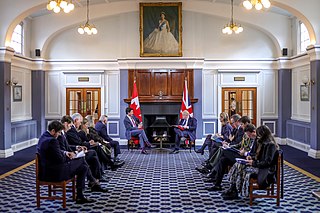
Royal Air Force Northolt or more simply RAF Northolt is a Royal Air Force station in South Ruislip, 2 nautical miles from Uxbridge in the London Borough of Hillingdon, western Greater London, England, approximately 6 mi (10 km) north of Heathrow Airport. The station handles many private civil flights in addition to Air Force flights. Northolt has one runway in operation, spanning 1,687 m × 46 m, with a grooved asphalt surface. This airport is used for government and VIP transport to and from London.

RAF Bentley Priory was a non-flying Royal Air Force station near Stanmore in the London Borough of Harrow. It was the headquarters of Fighter Command in the Battle of Britain and throughout the Second World War. During the war, two enemy bombs destroyed a wooden hut near the married quarters, a blast from a V-1 flying bomb broke a few windows, the windows in the Officers' Mess were shattered by a V-2 rocket, and a Vickers Wellington crashed outside the Sergeants' Mess.

Bridewell Palace in London was built as a residence of King Henry VIII and was one of his homes early in his reign for eight years. Given to the City of London Corporation by his son King Edward VI for use as an orphanage and place of correction for wayward women, Bridewell later became the first prison/poorhouse to have an appointed doctor.
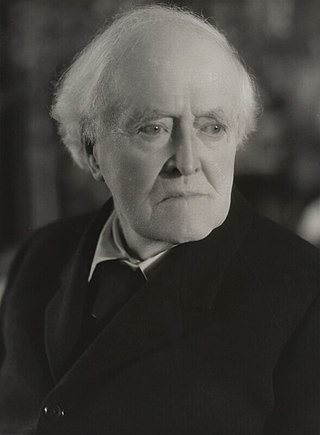
Charles Alfred Cripps, 1st Baron Parmoor, was a British politician who crossed the floor from the Conservative to the Labour Party and was a strong supporter of the League of Nations and of Church of England causes.

The Hamilton Princess & Beach Club, A Fairmont Managed Hotel is one of the grandest and most famous hotels in Bermuda, located in Pembroke Parish just outside the City of Hamilton. It also happens to be the oldest hotel in the Fairmont chains. One of the largest in Bermuda, it has over 400 rooms. It is one of two Fairmont Hotels on the island, the second being the Fairmont Southampton, which was originally opened as the Southampton Princess.

Northumberland Avenue is a street in the City of Westminster, Central London, running from Trafalgar Square in the west to the Thames Embankment in the east. The road was built on the site of Northumberland House, the London home of the Percy family, the Dukes of Northumberland between 1874 and 1876, and on part of the parallel Northumberland Street.

Royal Air Force Hemswell or more simply RAF Hemswell is a former Royal Air Force (RAF) station located 7.8 miles (12.6 km) east of Gainsborough, Lincolnshire, England.

Royal Air Force Tibenham or more simply RAF Tibenham is a former Royal Air Force station located 13.5 miles (21.7 km) southwest of Norwich and 5.8 miles (9.3 km) north of Diss, Norfolk, England.

Unilever House is a Grade II listed office building in the Neoclassical Art Deco style, located on New Bridge Street, Victoria Embankment in Blackfriars, London. The building has a tall, curving frontage which overlooks Blackfriars Bridge on the north bank of the River Thames.
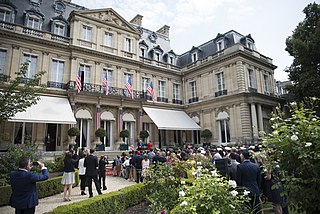
The Hôtel de Pontalba is a hôtel particulier, a type of large townhouse of France, at 41 Rue du Faubourg Saint-Honoré in the 8th arrondissement of Paris. It has been the official residence of the United States Ambassador to France since 1971.

The Corinthia Hotel London, at the corner of Northumberland Avenue and Whitehall Place in central London, is a hotel and former British Government building, located on a triangular site between Trafalgar Square and the Thames Embankment.

The royal prerogative is a body of customary authority, privilege, and immunity attached to the British monarch, recognised in the United Kingdom. The monarch is regarded internally as the absolute authority, or "sole prerogative", and the source of many of the executive powers of the British government.

Attorney-General v De Keyser's Royal Hotel Limited is a leading case in UK constitutional law decided by the House of Lords in 1920 which exhaustively considered the principles on which the courts decide whether statute has fettered prerogative power. It decided that the royal prerogative does not entitle the Crown to take possession of a subject's land or buildings for administrative purposes connected with the defence of the realm without paying compensation. It is the authority for the statement that the royal prerogative is placed in abeyance when statute law can provide a legal basis for an action.

Royal Air Force Harlaxton or more simply RAF Harlaxton is a former Royal Air Force station near the village of Harlaxton, 3 mi (4.8 km) south west of Grantham, Lincolnshire, England. The airfield was located in a triangle of flat fields midway between Harlaxton Manor and the nearby village of Stroxton.

SirPolydore de Keyser, was a lawyer and the first Roman Catholic since the Reformation to be elected Lord Mayor of London. He was born in the Belgian city of Dendermonde, near Ghent, Belgium.

The Carlton Hotel was a luxury hotel in London that operated from 1899 to 1940. It was designed by the architect C. J. Phipps as part of a larger development that included the rebuilding of Her Majesty's Theatre, which is adjacent to the hotel site. The Carlton was originally run by the Swiss hotelier César Ritz, with Auguste Escoffier as the head chef. In its early days it was one of London's most fashionable hotels and drew some customers away from the Savoy Hotel, which Ritz and Escoffier had previously managed.

The Hotel Cecil was a grand hotel built 1890–96 between the Thames Embankment and the Strand in London, England. It was named after Cecil House, a mansion belonging to the Cecil family, which occupied the site in the 17th century. The hotel was largely demolished in 1930, and Shell Mex House now stands on its site.

Royal Air Force Desford or more simply RAF Desford is a former Royal Air Force station located one mile (1.6 km) south of Desford, Leicestershire, and 6.7 miles (10.8 km) west of Leicester, Leicestershire, England.
Events in the year 1898 in Belgium.
